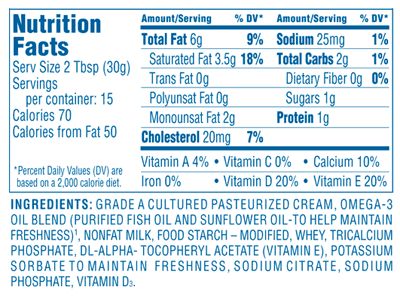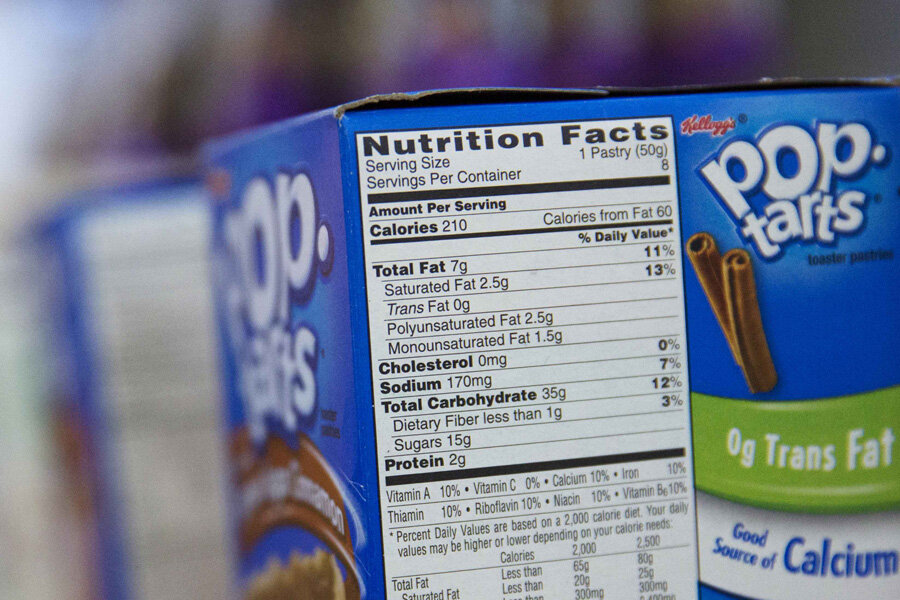42 food labels low fat
Food Packaging Claims | American Heart Association "Very Low" and "Low" means the food has a little more than foods labeled "Free." "Reduced" or "Less" mean the food has 25% less of a specific nutrient than the regular product. "More," "Fortified," "Enriched," "Added," "Extra," or "Plus" means the food has 10% or more of the Daily Value (DV) than the regular product. Fat labels - My Fearless Kitchen Percent fat free. Foods that are labeled with something like "90% fat free" must meet the criteria for the "low fat" label (3 grams of fat per serving or less). If the claim is "100% fat free," it must meet the criteria for a "fat free" label (less than 0.5 grams of fat per serving).
Looking at labels - British Nutrition Foundation They will allow you to make comparisons between products that are high, medium or low in fat, saturated, salt and sugar. Looking at the nutrition information on food labels can help you make healthier choices. Allergens will be listed and emphasised in the ingredients list. What are food labels and why use them?
Food labels low fat
How to Understand and Use the Nutrition Facts Label | FDA Nutrients to get less of: Saturated Fat, Sodium, and Added Sugars. Saturated fat, sodium, and added sugars are nutrients listed on the label that may be associated with adverse health effects - and... Understanding food labels | Diabetes UK The labels show how many calories are in the food or drink and are also colour coded to show whether the food is low (green), medium (amber) or high (red) in fat, saturated fat, sugar and salt. The information on the front of the pack also tells you how the portion of the food contributes to the Reference Intake (RI) of an adult. Low Fat Food Label Illustrations, Royalty-Free Vector Graphics & Clip ... Choose from Low Fat Food Label stock illustrations from iStock. Find high-quality royalty-free vector images that you won't find anywhere else.
Food labels low fat. Low-Fat Foods - American Cancer Society A good rule of thumb when you're reading food labels: For every 100 calories, if the product has 3 grams of fat or less, it's a low-fat product. This means 30% or less of the calories come from fat. ... Low-fat foods to choose from Dairy and dairy-like products. Low-fat (1%) or fat-free (skim) yogurt, cottage cheese, or milk; 13 Misleading Food Label Claims and How Not to Be Tricked The use of the term low-fat is governed by the FDA, which dictates that products must not contain more than 3 grams of fat per 50 grams. For meals and main dishes, foods are expected to contain no more than 3 grams of fat per 100 grams, and more than 30 percent of the calories cannot come from fat. 8. Label Says Made With Whole Grains How To Read Food and Beverage Labels - National Institute on Aging Reading food labels can help you make smart food choices. Learn how to read and understand the product date, ingredient list, and Nutrition Facts label. ... Low-fat, low-calorie, low-carb. These foods have a legal limit to how many calories, grams of fat, or carbohydrates (carbs) they can contain per serving. However, if a serving size is very ... Easy Guide to Understanding Food Labels When You Have High ... - MyDoc 1. Choose products low in saturated fat, trans fat and cholesterol. When shopping for food, use the nutrition information panel to compare and choose products with lower fat, saturated fat and cholesterol content. Saturated fat is a type of fat that raises your total and LDL cholesterol and risk of heart disease, so intake should be limited.
PDF Food Label Tip: How to Choose Foods Low In Saturated Fat, Trans Fat ... Fat-free milk is a better choice. Potato Chips Microwave Popcorn These food labels are for one serving of potato chips (about 12 chips) and one serving of microwave popcorn (1 cup). Microwave popcorn has the lowest % of saturated fat and the lowest amount of trans fat. It has 5% saturated fat and 0 grams of trans fat. Nutrition labelling | Food Standards Agency Mandatory information. When providing nutrition information, you are required to declare: energy value. amounts of fat, saturates, carbohydrate, sugars, protein and salt. The content of the mandatory nutrition declaration can be supplemented with an indication of the amounts of one or more of the following: monounsaturates. Reading Food Labels (for Parents) - Nemours KidsHealth Trans fat should be as low as possible (less than 1% of total calories). Unsaturated Fat Unsaturated fats may also be listed under total fat. Unsaturated fats are often called "good fats" because they don't raise cholesterol levels as saturated fats do. Most fats should come from sources of unsaturated fats. Cholesterol How to Read Food Labels Without Being Tricked - Healthline Still, processed foods that are labeled low-carb are usually still processed junk foods, similar to processed low-fat foods. Made with whole grains. The product may contain very little whole ...
Understanding Food Terms - American Cancer Society Low-fat: 3 g (grams) or less per serving; Low-saturated fat: 1 g or less per serving, with not more than 15% of the calories coming from saturated fat; Low-sodium: 140 mg (milligrams) or less per serving; Very low sodium: 35 mg or less per serving; Low-cholesterol: 20 mg or less per serving; Low-calorie: 40 calories or less per serving; Lean and extra lean Food labels: why 'low-fat' and 'high-fibre' don't mean healthy The claim: Low-fat. The truth: must contain less than 3g of fat per 100g for food or 1.5g of fat per 100ml for drinks. But this does not mean the product is healthy or low-calorie. Many low fat ... How to understand food labels - Eat For Health Sometimes labels will include nutrition content claims like 'low fat', 'reduced salt' or 'high fibre'. These claims can only be used if the food meets certain criteria. For example, with a 'good source of calcium' claim, the food must contain more than a set amount of calcium. Food Labels: Fat & Cholesterol | Home & Garden Information Center When comparing food labels, combine the grams (g) of saturated fat and trans fat, then choose the food with the lower combined amount. Look for the lowest % Daily Value for cholesterol, also. Ingredients List: When a food is made with more than one ingredient, an ingredients list is required on the label. Ingredients are listed in order by weight, with the greatest amount listed first and the least amount last.
Food Labels | CDC If you eat the whole thing, you are eating 8 times the amount of calories, carbs, fat, etc., shown on the label. Total Carbohydrate shows you types of carbs in the food, including sugar and fiber. Choose foods with more fiber, vitamins, and minerals. Choose foods with lower calories, saturated fat, sodium, and added sugars. Avoid trans fat.
How to Read Food Labels for a Heart-Healthy Diet The lower the net carbs, the better." Berries: "I usually choose blueberries, which are anti-inflammatory and not as high in sugar as bananas.". Yogurt: "I choose a low-fat brand that's marketed as 'diabetes friendly' on the label, which means it's low in carbohydrates. You get all the benefit of yogurt with far fewer carbs.
Check the label | Food Standards Agency The traffic light labelling system will tell you whether a food has high, medium or low amounts of fat, saturated fat, sugars and salt. It will also tell you the number of calories and kilojoules...
Nutrition claims - Food Safety LOW SATURATED FAT. A claim that a food is low in saturated fat, and any claim likely to have the same meaning for the consumer, may only be made if the sum of saturated fatty acids and trans-fatty acids in the product does not exceed 1,5 g per 100 g for solids or 0,75 g/100 ml for liquids and in either case the sum of saturated fatty acids and ...
Food labels - NHS Colour-coded nutritional information tells you at a glance if the food has high, medium or low amounts of fat, saturated fat, sugars and salt: red means high; amber means medium; green means low; In short, the more green on the label, the healthier the choice.
Food Labels: What does the 'low fat' label actually mean? To get you up to speed, a product can only use the low-fat claim if it has less than 3g fat per 100g (and if it's a liquid, it has to have less than 1.5g fat per 100g). In essence, that means that just because something is labelled as low fat, it doesn't automatically make it healthy - it could be bursting with sugar or salt instead.
Food labelling and packaging - GOV.UK You have to follow certain rules if you want to make a nutrition claim (for example, low fat) or a health claim (for example, calcium helps maintain normal bones). You cannot claim or imply that...
Food labelling - get into the habit of checking the label Look for five key points on the label: 1. Energy The terms 'kJ' and 'kcal' (calories) tell you how much energy is in a product. Women need an average of 2,000 kcal a day and men need 2,500 kcal on average. 2. Saturates Saturates is another word for saturated fat. This section tells you about the amount of saturated fat in the product. 3. Salt
Food Labeling & Nutrition | FDA Food labeling is required for most prepared foods, such as breads, cereals, canned and frozen foods, snacks, desserts, drinks, etc. Nutrition labeling for raw produce (fruits and vegetables) and...
Don't Be Fooled By These Food Labels - Health.com Two percent milk sounds great—it's such a low number! What most people don't realize is that whole milk contains only 3.25% fat. So 2% milk contain less fat than regular milk, but not that much. It...
What the Labels Mean - Calorie Control Council LOW-FAT 3 grams or less of total fat for a given reference amount LOW-CALORIE no more than 40 calories for a given reference amount (except sugar substitutes) LOW-CHOLESTEROL 20 milligrams or less cholesterol and 2 grams or less of saturated fat for a given reference amount
Low Fat Food Label Illustrations, Royalty-Free Vector Graphics & Clip ... Choose from Low Fat Food Label stock illustrations from iStock. Find high-quality royalty-free vector images that you won't find anywhere else.
Understanding food labels | Diabetes UK The labels show how many calories are in the food or drink and are also colour coded to show whether the food is low (green), medium (amber) or high (red) in fat, saturated fat, sugar and salt. The information on the front of the pack also tells you how the portion of the food contributes to the Reference Intake (RI) of an adult.
How to Understand and Use the Nutrition Facts Label | FDA Nutrients to get less of: Saturated Fat, Sodium, and Added Sugars. Saturated fat, sodium, and added sugars are nutrients listed on the label that may be associated with adverse health effects - and...











Post a Comment for "42 food labels low fat"